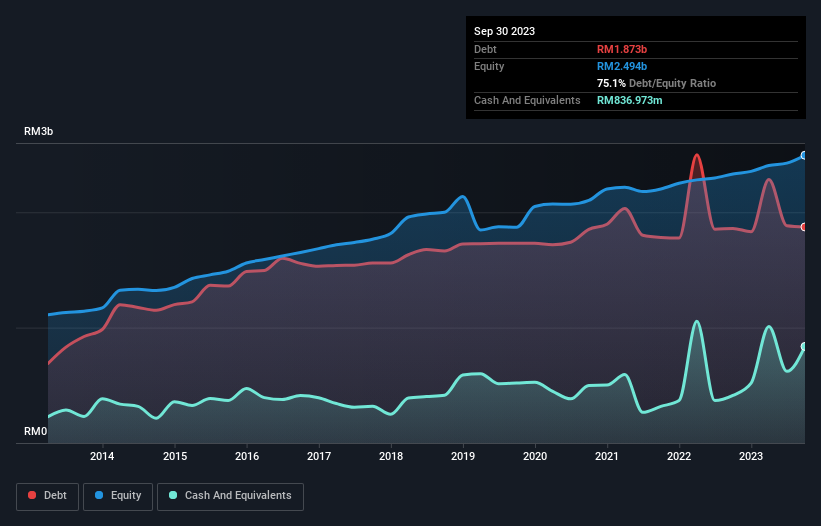
Legendary fund manager Li Lu (who Charlie Munger backed) once said, 'The biggest investment risk is not the volatility of prices, but whether you will suffer a permanent loss of capital.' So it might be obvious that you need to consider debt, when you think about how risky any given stock is, because too much debt can sink a company. As with many other companies KPJ Healthcare Berhad (KLSE:KPJ) makes use of debt. But the more important question is: how much risk is that debt creating?
When Is Debt Dangerous?
Generally speaking, debt only becomes a real problem when a company can't easily pay it off, either by raising capital or with its own cash flow. In the worst case scenario, a company can go bankrupt if it cannot pay its creditors. However, a more usual (but still expensive) situation is where a company must dilute shareholders at a cheap share price simply to get debt under control. Of course, debt can be an important tool in businesses, particularly capital heavy businesses. When we think about a company's use of debt, we first look at cash and debt together.
View our latest analysis for KPJ Healthcare Berhad
How Much Debt Does KPJ Healthcare Berhad Carry?
The chart below, which you can click on for greater detail, shows that KPJ Healthcare Berhad had RM1.87b in debt in September 2023; about the same as the year before. However, because it has a cash reserve of RM837.0m, its net debt is less, at about RM1.04b.

A Look At KPJ Healthcare Berhad's Liabilities
The latest balance sheet data shows that KPJ Healthcare Berhad had liabilities of RM1.41b due within a year, and liabilities of RM3.39b falling due after that. Offsetting this, it had RM837.0m in cash and RM846.2m in receivables that were due within 12 months. So its liabilities total RM3.12b more than the combination of its cash and short-term receivables.
KPJ Healthcare Berhad has a market capitalization of RM6.85b, so it could very likely raise cash to ameliorate its balance sheet, if the need arose. But we definitely want to keep our eyes open to indications that its debt is bringing too much risk.
In order to size up a company's debt relative to its earnings, we calculate its net debt divided by its earnings before interest, tax, depreciation, and amortization (EBITDA) and its earnings before interest and tax (EBIT) divided by its interest expense (its interest cover). The advantage of this approach is that we take into account both the absolute quantum of debt (with net debt to EBITDA) and the actual interest expenses associated with that debt (with its interest cover ratio).
Looking at its net debt to EBITDA of 1.5 and interest cover of 2.7 times, it seems to us that KPJ Healthcare Berhad is probably using debt in a pretty reasonable way. So we'd recommend keeping a close eye on the impact financing costs are having on the business. Importantly, KPJ Healthcare Berhad grew its EBIT by 43% over the last twelve months, and that growth will make it easier to handle its debt. When analysing debt levels, the balance sheet is the obvious place to start. But it is future earnings, more than anything, that will determine KPJ Healthcare Berhad's ability to maintain a healthy balance sheet going forward. So if you want to see what the professionals think, you might find this free report on analyst profit forecasts to be interesting.
Finally, a business needs free cash flow to pay off debt; accounting profits just don't cut it. So it's worth checking how much of that EBIT is backed by free cash flow. Over the most recent three years, KPJ Healthcare Berhad recorded free cash flow worth 69% of its EBIT, which is around normal, given free cash flow excludes interest and tax. This cold hard cash means it can reduce its debt when it wants to.
Our View
Happily, KPJ Healthcare Berhad's impressive EBIT growth rate implies it has the upper hand on its debt. But the stark truth is that we are concerned by its interest cover. It's also worth noting that KPJ Healthcare Berhad is in the Healthcare industry, which is often considered to be quite defensive. When we consider the range of factors above, it looks like KPJ Healthcare Berhad is pretty sensible with its use of debt. That means they are taking on a bit more risk, in the hope of boosting shareholder returns. When analysing debt levels, the balance sheet is the obvious place to start. But ultimately, every company can contain risks that exist outside of the balance sheet. To that end, you should learn about the 2 warning signs we've spotted with KPJ Healthcare Berhad (including 1 which can't be ignored) .
If you're interested in investing in businesses that can grow profits without the burden of debt, then check out this free list of growing businesses that have net cash on the balance sheet.
Valuation is complex, but we're here to simplify it.
Discover if KPJ Healthcare Berhad might be undervalued or overvalued with our detailed analysis, featuring fair value estimates, potential risks, dividends, insider trades, and its financial condition.
Access Free AnalysisHave feedback on this article? Concerned about the content? Get in touch with us directly. Alternatively, email editorial-team (at) simplywallst.com.
This article by Simply Wall St is general in nature. We provide commentary based on historical data and analyst forecasts only using an unbiased methodology and our articles are not intended to be financial advice. It does not constitute a recommendation to buy or sell any stock, and does not take account of your objectives, or your financial situation. We aim to bring you long-term focused analysis driven by fundamental data. Note that our analysis may not factor in the latest price-sensitive company announcements or qualitative material. Simply Wall St has no position in any stocks mentioned.
About KLSE:KPJ
KPJ Healthcare Berhad
An investment holding company, engages in the operation of specialist hospitals in Malaysia, Thailand, and Bangladesh.
Excellent balance sheet with proven track record.
Similar Companies
Market Insights
Community Narratives



